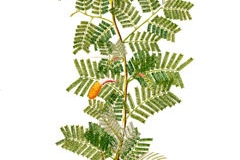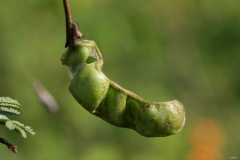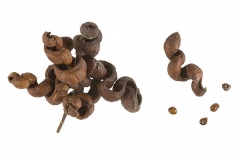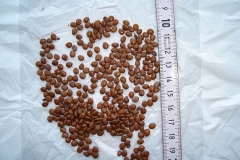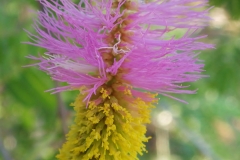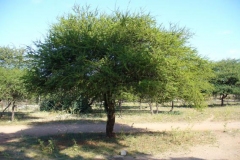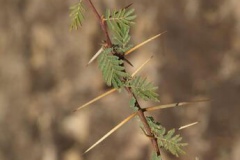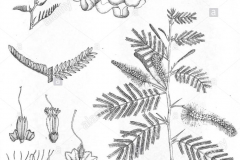The generic name Dichrostachys means ‘two-colored spike’, referring to its two-colored inflorescence, from the Ancient Greek δί- (di-, ‘twice’), χροός (khroos, ‘color’), and στάχυς (stakhus, ‘ear of grain’). The specific name cinerea is from the Greek ‘konis’ and Latin ‘cineres’, referring to the grey hairs on the subspecies confined to India. The species is most commonly known as the ‘sickle bush’ derived from the curved shape of the pods. The plant is covered with spines and is occasionally suckering and thicket-forming. It is a true multi-purpose tree, providing food, medicines, fuel and various commodities. Bark, roots, and leaves are used in the treatment of dysentery, headaches, toothaches, elephantiasis, snakebites and scorpion stings, leprosy, syphilis, coughs, epilepsy, gonorrhea, boils, and sore eyes. It has a strong capacity for natural regeneration and used in soil conservation. Bark produces strong fiber used as twine. Debarked roots are used for racks and baskets. The wood is used as walking sticks, handles, spears, and tool handles. Sicklebush is a highly variable thorny, deciduous or semi deciduous shrub or small tree that normally grows about 1 – 8 meters tall with occasional specimens to 12 meters with a rounded crown about 3 m wide. The crown is often umbrella shaped, sparse, flattish and rather untidy. Trunk may be twisted and is less than 23 cm wide. When mature it may become deeply fissured and dark grey-brown. The plant is found growing in poor, occasionally clayey soils, in brushwood, thickets, hedges, teak forest and grassland to elevations of 1,700 meters. It often forms widespread thickets by means of root suckers. The plant succeeds in a range of soils from clays, through loams to sandy soils. It requires a well-drained soil and also succeeds in poor soils. It requires little water and full sun. Mature plants can withstand moderate frost, but young plants must be protected from frost. It grows fairly quickly and requires frequent pruning to keep it neat. Due to its size and very thorny nature, it is not suited to small gardens. Bark surface is nearly smooth to rough or deeply fissured, dark grey to greyish brown, peeling off in strips, inner bark is thick, fibrous, yellowish white; crown open, with spreading branches; lateral twigs with sharp spines at apex, short-hairy. Prominent light Lenticels are present. Lateral Branches tend to occur near the base and are spinescent (having or becoming spiny) and the single Spines are almost alternatively arranged and are not in pairs. Each spine is up to 8 cm long and ends in a sharp point that may be slightly recurved. This deciduous tree has alternate, bipinnately compound leaves similar to those of the acacia and is up to 20 cm long. They may appear in a bundle on dwarf spur branches or are clustered on the spines. There may be up to 41 pairs of olive-green leaflets. The leaflets may be slightly glossy above and dull below. They are small up to 12 mm long and 3mm wide and obovate or lanceolate. Leaves close up soon after picking and are best observed on the tree. The hairy rachis has long, protruding thin glands between some of the pairs of pinnae. These glands end in a pinhead-like tip. The petiole has no gland and is up to 5 cm long. The impressive bisexual and sessile flowers are borne in leaf axils and are actinomorphic. They are scented and found in pendulous, cylindrical bicolored spikes up to 8 cm long. The flowers closest to the stem are infertile, pinkish-mauve or white and have protruding staminodes. Color may vary even on the same tree. Flowers at the end of the hanging spike are bisexual and bright yellow. This arrangement clearly indicates the distinctive difference between itself and the acacias. Calyx is bell-shaped and has 5 Sepal lobes which end tooth-like. Bell-shaped corolla has 5 non-overlapping petal lobes. There are 10 yellow stamens in bisexual flowers and these occur in 2 whorls of 5 each. These extend slightly beyond the petals. Anthers have stalked glands. There is a single Pistil (a unit of the Gynoecium, the female element of the flower, composed of the Ovary, Style and Stigma). Flowering normally takes place from September to June in Indonesia and October to February in South Africa. Fertile flowers are followed by curled, twisted, sickle shaped and leathery indehiscent pod. Each spike produces a mass of flat, coiled pods. They are distinctive clustered together with many other pods. Fruits are initially green turning to dark brown, hard and up to 10 cm long and 1.5 cm wide before falling. Each pod consists of up to 4 black smooth seeds. Some seeds may have more than 1 embryo. The flattened, glossy brown, compressed, ovoid to ellipsoid seeds, about 4-6 mm long and 3-45 mm wide is released when the pod decays on the ground. The plant is native to Africa, Indian subcontinent and North Australia and introduced to the Caribbean and parts of Southeast Asia. In Ethiopia, the species is common in the Nechisar National Park. The tree was brought to the Caribbean in the 19th century. In Cuba, where it is known as El Marabú or Marabou weed, it has become a serious invasive species problem, occupying close to five million acres (20,000 km²) of agricultural land. Plans are underway to exploit it as a source of biomass for renewable power generation. References: https://www.itis.gov/servlet/SingleRpt/SingleRpt?search_topic=TSN&search_value=26668#null http://www.hear.org/pier/species/dichrostachys_cinerea.htm https://npgsweb.ars-grin.gov/gringlobal/taxon/taxonomydetail?id=100199 https://pfaf.org/user/Plant.aspx?LatinName=Dichrostachys+cinerea https://www.cabi.org/isc/datasheet/18119 http://www.plantsoftheworldonline.org/taxon/urn:lsid:ipni.org:names:492423-1 https://gd.eppo.int/taxon/DIRCI https://indiabiodiversity.org/species/show/279359 https://uses.plantnet-project.org/en/Dichrostachys_cinerea_(PROTA) http://www.theplantlist.org/tpl1.1/record/ild-23 https://en.wikipedia.org/wiki/Dichrostachys_cinerea https://www.feedipedia.org/node/298 http://www.flowersofindia.net/catalog/slides/Sickle%20Bush.html http://pza.sanbi.org/dichrostachys-cinerea http://apps.worldagroforestry.org/treedb/AFTPDFS/Dichrostachys_cinerea.PDF https://indiabiodiversity.org/species/show/229560 https://plants.usda.gov/home/plantProfile?symbol=DICI2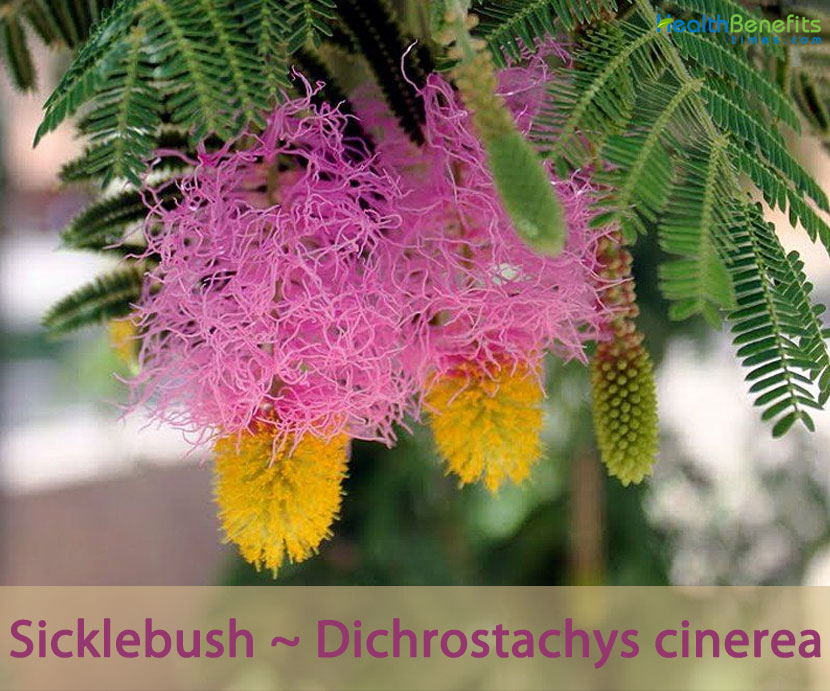
Sicklebush Quick Facts
Name:
Sicklebush
Scientific Name:
Dichrostachys cinerea
Origin
Africa, Indian subcontinent and North Australia and introduced to the Caribbean and parts of Southeast Asia
Colors
Green when young turning to dark-brown as they mature
Shapes
Curled, twisted, sickle shaped and leathery indehiscent pod
Taste
Bitter, astringent, acrid, pungent
Dichrostachys cinerea, popularly known as sicklebush or Chinese lantern tree is a legume of the genus Dichrostachys in the Fabaceae / Leguminosae (Pea family). The plant is native to Africa, Indian subcontinent and North Australia and introduced to the Caribbean and parts of Southeast Asia. In Africa it occurs in all regions except the rain forest belt, from Cape Verde eastward to Somalia and southward to Namibia and northern South Africa. In Ethiopia, the species is common in the Nechisar National Park. Chinese lantern tree, Kalahari Christmas tree, Saint Domingue, Sen Domeng, acacia Saint Domingue, aroma, marabú, marabou-thorn, sickle bush, Bell mimosa, Chinese lantern, sickle pod, Princess Earrings, mazabu, Arzik, Bilatri, Bortuli, Chipangala, Evagia, Ithalala, Khairi, Kolai, Kunlai, Mkingiri, Moselesele, Muvilisya, Muwanika, N’talala, Odatare, Segum-kati, Sekelbos, Veltura, Vidattalai, Vurtuli, ami ogwu, dundu, kara, sickle bush and virtuli are some of the popular common names of the plant.
Health benefits
Beneficial for dysentery, headaches, toothaches, elephantiasis, snakebites and scorpion stings, leprosy, syphilis, coughs, epilepsy, gonorrhea, boils, and sore eyes
Sicklebush Facts
Name
Sicklebush
Scientific Name
Dichrostachys cinerea
Native
Africa, Indian subcontinent and North Australia and introduced to the Caribbean and parts of Southeast Asia. In Africa it occurs in all regions except the rain forest belt, from Cape Verde eastward to Somalia and southward to Namibia and northern South Africa. In Ethiopia, the species is common in the Nechisar National Park
Common Names
Chinese lantern tree, Kalahari Christmas tree, Saint Domingue, Sen Domeng, acacia Saint Domingue, aroma, marabú, marabou-thorn, sickle bush, Bell mimosa, Chinese lantern, sickle pod, Princess Earrings, mazabu, Arzik, Bilatri, Bortuli, Chipangala, Evagia, Ithalala, Khairi, Kolai, Kunlai, Mkingiri, Moselesele, Muvilisya, Muwanika, N’talala, Odatare, Segum-kati, Sekelbos, Veltura, Vidattalai, Vurtuli, ami ogwu, dundu, kara, sickle bush, virtuli
Name in Other Languages
Afrikaans: Sekelbos, Kleinblaarsekelbos
Amharic: Ader,ergett-dimmo
Arabic: Hajujum ramadiun (حجوجم رمادي), hurgam, kaddad, kadada, hurgan, heghem, hegam, um Kedad,kadad
Assamese: Beerbrikshya (বীৰবৃক্ষ)
Bambara: Giliki, Ntirigi
Bemba: Kansalonsalo, katenge
Burkina Faso: Agarof, kurkur
Cape Verde: Espinho cachupa, spinho cachupa
Chinese: Dài ér chá (代儿茶)
Cuba: Marabu, marabú
English: Aroma, Marabou-thorn, Sicklebush, Chinese lantern, Ugagu, Princess Earrings, Bell Mimosa, Chinese Lantern Tree, Kalahari Christmas Tree, marabou, ashy babool
Finnish: Aitalyhtyakaasia
French: Mimosa clochette, acacia saint domingue, dichrostachys cendré, kéké, acacia de Saint-Domingue
German: Kalahari-Weihnachtsbaum
Gujarati: Kellumtaro, Mordundiyan, marud (મરૂઢ), mordhundhayu (મોરઢુંઢયુ), veltur (વેલતુર)
Hebrew: שיח-מגל
Hindi: Bilatri, marult, odatare, segum-kati, vadatalla, veltu, veltura, vidattalai, vurtuli, wadu, velantara, virataru, kunali, khairi, kheri (खेरी), kunali (कुणाली), shami (शमी), velati (वेलाटी), virataru (वीरतरु)
Kachchhi: Kini kheradi (કીની ખેરડી)
Indonesian: Epung, pung, pereng
Irula: Odavarai
Kannada: Odavinaha, Vaduvarada gida, edatari (ಎಡತರಿ), shami (ಶಮಿ), vadavina (ವದವಿನ), vaduvarada mara (ವಡುವಾರದ ಮರ)
Kinyarwanda: Umuyebe
Konkani: Sigam kamti (सिगम कांटी)
Malayalam: Veṭatala (വെടതല), vīravr̥kṣaṁ (വീരവൃക്ഷം), vitattal, veeravriksham (വീരവൃക്ഷം)
Marathi: durangi babhul (दुरंगी बाभूळ), sigam kati (सिगम काटी)
Mali: Giliki, ntirigi
Nigeria: D’und’u
Oriya: Khoiridya
Portuguese: Marabu, espinho cachupa, spinho cachupa
Rajasthani: goya khair (गोया खैर)
Sanskrit: Bahuvaraka (बहुवारक), dirghamula (दीर्घमूल), mahakapittha (महाकपित्थ), virataru (वीरतरु), viravriksha (वीरवृक्ष)
Senegal: Bourri, m’buuri, ntirigi, patroulahi, seb, sinke
Shona: Mumhangara, Mupangara, Muruka, Musekera
South Africa: Kalahari Christmas tree; sekelbos; tassels for the chief’s hat
Spanish: Aroma, Marabú
Sudanese: Peu’eung, kakada
Swedish: Mkulagembe, mkingiri, msigino, mvunja shoka
Tamil: Vidatalai, veluturu, veduttalam, vidattalai chettu, anai-t-ter (ஆனைத்தேர்) varittula (வரித்துலா), vetuttalam (வெடுத்தலாம்), vira-taru (வீரதரு), vitatterai (விடத்தேரை)
Telugu: Lathuga, Nellajammi, venuturu, veluturuchettu (వెలుతురుఛెట్టు)
Tulu: Shami (ಶಮಿ)
Tsonga: Ndzhenga
Wolof: Seb, sinke, Sëng
Plant Growth Habit
Highly variable thorny, deciduous or semi deciduous shrub or small tree
Growing Climates
Usually on poor, occasionally clayey soils, in brushwood, thickets, hedges, teak forest and grassland to elevations of 1,700 meters. Often forms widespread thickets by means of root suckers
Soil
Succeeds in a range of soils from clays, through loams to sandy soils. Requires a well-drained soil. Succeeds in poor soils
Plant Size
1 – 8 meters tall, with occasional specimens to 12 meters with a rounded crown, 3 m wide
Stem
stems are often twisted and twined together
Bark
Bark on young branches is green and densely to sparsely puberulous, and on the older branches is dark-grey brown and longitudinally fissured. The branches have strong alternate lateral shoots to 8 cm long appearing as thorns that may have leaves at the base.
Leaf
Alternate, bipinnately compound leaves similar to those of the acacia and is up to 20 cm long
Flowering season
Flower
Impressive bisexual and sessile flowers are borne in leaf axils and are actinomorphic. They are scented and found in pendulous, cylindrical bicolored spikes up to 8 cm long
Fruit Shape & Size
Curled, twisted, sickle shaped and leathery indehiscent pod
Fruit Color
Green when young turning to dark-brown as they mature
Seed
Flattened, glossy brown, compressed, ovoid to ellipsoid seeds, about 4-6 mm long and 3-45 mm wide is released when the pod decays on the ground.
Propagation
By Seed, suckers
Taste
Bitter, astringent, acrid, pungent
Plant Parts Used
Roots, shoots, stem bark, heart wood
Season
Precautions
Plant Description
Bark
Leaves
Flowers
Fruit
History
Traditional uses and benefits of Sicklebush
Ayurvedic Health benefits of Sicklebush
Other Facts
Comments
Awesome


